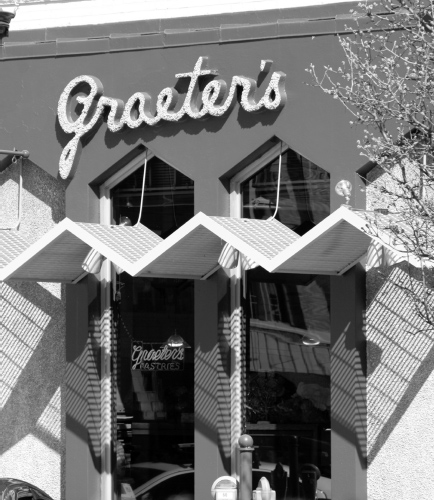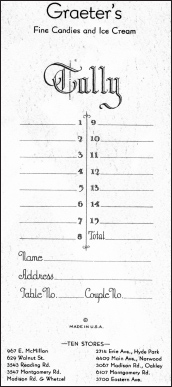Greater's Ice Cream (3 page)
Read Greater's Ice Cream Online
Authors: Robin Davis Heigel
Tags: #Graeter’s Ice Cream: An Irresistible History

The same year that Louis Charles was killed, the Cincinnati Reds won their first World Series against the Chicago White Sox. The title was soon tarnished, however, because members of the Chicago team were suspended for purposely losing the series for financial gain.
Graeter's was not the only family-owned ice cream business in town during this time. Thomas and Nicholas Aglamesis, who settled in Cincinnati from Sparta, Greece, started Aglamesis Brothers Ice Cream in 1908. The duo opened their first ice cream shop, called the Metropolitan, in Norwood, an eastern Cincinnati community. A second store in Oakley followed in 1913. The product was similar, though it was not made in French pots as Graeter's was. And, unlike the Graeters, the Aglamesis brothers were content with their two stores.
Regina had a different vision for her business. Despite being a young widow, she was determined to persevere, not just continuing with the single store but expanding it. She opened the first satellite stores on Walnut Street downtown and then in Hyde Park, which became one of Cincinnati's wealthiest enclaves. The store, which was originally part of Higginson's Tea Room, stood in Hyde Park Square, which was developed in 1900 as a center for shopping and community identity. This store at 2704 Erie Avenue is still in operation today and is the oldest operating Graeter's retail store.

The Graeter's store in Hyde Park is the oldest of the stores still in operation. It opened in 1920.
Courtesy of Ken Heigel
.
To help with the family business, young Wilmer, the oldest son of Louis Charles and Regina, dropped out of school in the eighth grade, because he was more interested in driving a truck, his son Dick said.
“If Wilmer was around today, he would be one of those kids labeled ADHD,” Dick said. “He was really smart, he just didn't do well in school.” But he was, Dick remembers, very creative and artistic, an unusual combination of characteristics for someone who worked with his hands.
His younger brother, Paul, on the other hand, finished high school, though he didn't go to college.
By 1929, Regina had opened six new stores in Cincinnati, including ones in Norwood, Madisonville, Avondale and Pleasant Ridge. To manage the volume of ice cream needed, the company purchased a manufacturing facility on Reading Road in Mount Auburn in 1934 during the height of the Great Depression. The family turned a building that once housed an old printing press into an ice cream and chocolate production plant. All of the ice cream for the retail stores started being produced on Reading Road in 1937.

The back of a tally sheet from the 1930s lists store locations at the time.
Courtesy of The History Press.
As history would prove over and over, people always made room for the little luxuries in life, such as ice cream. While other businesses faltered and failed, Graeter's grew during the most difficult economic time in the country's history.
By the end of World War II, Graeter's Ice Cream included a network of stores that spanned Cincinnati. By this time, Wilmer and Paul were heavily involved in the
business, but it was Regina whom everyone, including her sons, called “the boss.”
Her great-grandson, Richard Graeter II, believes she must have been a remarkable person, managing everything from the death of her husband to the business through two world wars and the Great Depression, at a time when most women didn't work outside the home at all, let alone run a business.
“I never met her, but I owe her for everything I have,” her great-grandson Richard said, “because without her strength, fortitude and foresight, there would be no Graeter's Ice Cream today.”
By the 1940s, America was fully engaged in World War II on the European and Pacific fronts. While it took men from their homes to staff the military and forced rationing for the civilian public on everything from sugar to gasoline, the war alleviated unemployment. During the Great Depression, as many as eight million people were out of work, and another eight million lived below the poverty line. By 1941, the country had virtually no unemployment. In fact, some industries actually experienced labor shortages. Many women went to work, even in factories, to help with the war effort, making up 36 percent of the nation's total workforce by 1945.
As she had in the decades before, Regina Graeter remained at the helm of Graeter's Ice Cream through the war. The rationing of sugar became a particular problem because ice cream couldn't be made without it. “You couldn't get sugar,” said Dick Graeter.
“I worked in a couple of stores during the war years. You'd almost run out of product. Eventually I think they started
to get black market sugar, which helped considerably,” he speculated.
The black market became a way of life for some people and businesses during the war because it was the only way they could get what they needed, whether that be meat, gasoline or sugar, albeit at a higher price.
One way that Americans helped in the war effort was to grow “victory gardens,” in which they planted their own fruits and vegetables. It was estimated that by 1945, twenty million gardens produced 45 percent of America's produce.
After World War II, thousands of soldiers reentered the civilian workplace, and women returned to the home. Many businesses that had made money on the war now invested it in new plants and equipment for civilian production. Frugal Americans had saved money during the war that they now could spend on new houses and cars.
Marriage rates soared after the war, as did the birthrate, which became known as the Baby Boom. Between 1948 and 1953, more children were born than in the previous thirty years. In 1954, the country experienced the largest one-year population gain in history. The Baby Boom would reshape the American family for decades to come. In the late 1940s and early 1950s, for example, Americans considered it ideal to have a ranch or split-level house, one car and three children, with a husband and father as the primary breadwinner and a stay-at-home wife as mother and housekeeper. From this ideal sprang the suburbs: single-family homes with yards located away from industry. In Cincinnati, new subdivisions popped up in the surrounding hills of the city, and the new middle class flocked to them.
So many people left the downtown area that by the 1950s, Cincinnati underwent what was happening all over the country: urban renewal. But as happened in other cities, the renewal was done by bulldozer. Cincinnati embarked on the country's
second largest slum clearance until that time. Thousands of buildings were razed, leaving thousands of families displaced.
The areas where Graeter's Ice Cream stores had originally expanded toâOakley, the East End, Bond Hillâbecame increasingly working class and, in some cases, new slums. Stores set up by Regina had to move to follow the population that would buy ice cream, to places such as Westwood, Price Hill and Mariemont.
HANGES IN
I
CE
C
REAM
It wasn't just the landscape of cities that changed. Advancements in manufacturing changed many things, from cars and appliances to ice cream.
Until after the war, virtually all ice cream manufacturers created their product by a method known as “batch freezing,” which was similar to what was done at Graeter's, though not in true French pots. But after the war, commercial refrigeration and more sophisticated ice cream makers came along, and batch freezers disappeared. With the continuous commercial freezers, the mix of cream, sugar and eggs was poured in and quickly whipped with fast-moving beaters. These machines continuously spit out the ice creamâbasically the antithesis of Graeter's.
At Graeter's, the mix was cranked in small batchesâeven today, a batch of Graeter's makes only two and a half gallonsâand had to be scraped by hand from the sides of the pots and hand-packed into cartons. The Graeter's method incorporated the least amount of air into the ice cream, making it more dense and luxurious.
Dick Graeter remembers trying to make Graeter's Ice Cream in one of the newer ice cream makers when he joined
the company in the 1950s. “You couldn't make the product that we were making in that type of a freezer. It would turn it into butter,” Dick said. “I tried that several different times when I came here.”
The new machines created a version of ice cream that was lighter in texture and airier than Graeter's. By law, ice cream could have as much as 100 percent overrun, or be as much as 50 percent whipped-in air. It was, in essence, frozen foam. Graeter's had (and still has) only a small amount of air that inevitably gets mixed in during the freezing process, just between 20 and 25 percent. A pint of Graeter's weighs almost a pound, whereas the competition's ice cream might weigh half as much.
Dick insists it wasn't just a pure love of the product that kept them from giving up the labor-intensive French pot method for a perhaps more lucrative continuous freezer version. “I always said that we were too dumb to make the next step, didn't know any better.”
The changes in ice cream production came hand in hand with the onset of commercial dairy farms. The number of small dairy farms dwindled starting in the 1930s for more than fifty years because it became cost-prohibitive. Dairy farmers figured out what to feed cows to get the maximum output in milk. The annual average yield per cow rose from 3,000 pounds in 1890 to 4,500 pounds in 1950.
Insulated trucks led to larger milk-processing plants, which could process the milk at a much lower cost. Dairy products, including the milk and cream needed for ice cream, decreased in price. For dairy farms to make money, they needed bigger operations.
Local competition in ice cream increased with the introduction of United Dairy Farmers (UDF) in the 1940s. Started by Carl H. Lindner Sr. and carried on by his children, the group started one of the first dairy stores, where milk and other dairy products, including ice cream, were sold instead of home delivered. Despite growing popularity and convenience, the UDF ice cream was made by the continuous method, making the product a far cry from the hand-packed, dense ice cream made at Graeter's.

The plant at Reading Road includes pots for cream and men making the ice cream to the left.
Courtesy of the Cincinnati Historical Museum
.
Another change to the ice cream industry was the introduction of soft serve, which became possible because of new equipment that hadn't been available until this time. “There was a soft serve place on every corner after the war,” Dick said. “It really put the ice cream businesses like ours out of business. All ice cream like ours was sold in drugstores. There wasn't a drugstore anywhere that didn't have an ice cream fountain.” Soft serve, sometimes referred to as frozen custard, was new and differentâand widely available.
Like many culinary inventions, the history of soft serve is not definite. More than one claim to its creation exists. In one
version, the silky smooth semi-frozen mixture was created by the founders of Dairy Queen, J.F. McCullough and his son, Alex, in Davenport, Illinois, about 1927. The duo decided to see if customers preferred ice cream in a softer state, before it was completely frozen. When they found that it was a hit with consumers, they started looking for machinery that would make it possible. In 1939, they found the necessary equipment. They opened the first Dairy Queen in 1940, and the phenomenon took off from there.
